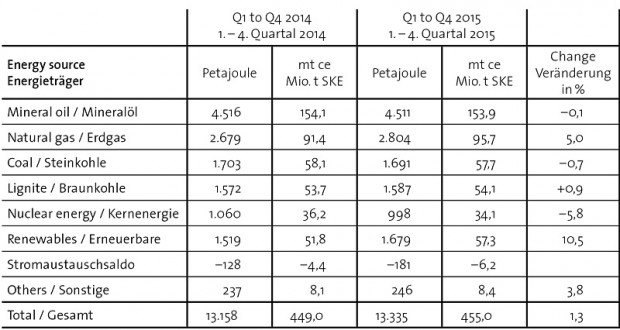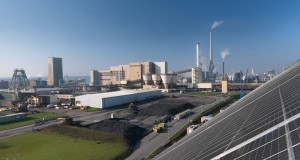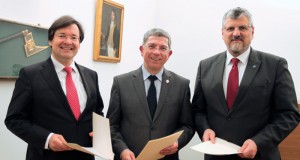Energy consumption in Germany reached 13,335 PJ or 455.0 mt ce in 2015. According to provisional calculations by AG Energiebilanzen (German Working Group on Energy Balances), this constitutes a 1.3 % increase on the previous year. This rise is due for the most part to slightly colder weather compared with that in 2014, which was very mild, and the consequent need for more heating. AG Energiebilanzen estimates that the increase in consumption resulting from positive economic trends (+1.8 %) and population growth (+ one million people) have been offset by improvements in energy efficiency. When adjusted to take account of the weather, the working group maintains that energy consumption this past year has actually dropped by 1.5 to 2 %. As regards CO2 emissions, AG Energiebilanzen claims that these have risen slightly compared with the previous year. A significant part of this consumption increase could be covered by renewable energies, the use of which would not result in emissions levels rising. The equally high level of mineral oil consumption and the declining use of coal have also reduced CO2 emissions. When adjusted in view of the change in temperature, CO2 emissions are now around 2 % less than they were last year.
Consumption of mineral oil in 2015 remained virtually the same as it was the year before. Consumption reached a total of 4,511 PJ or 153.9 mt ce, a decrease of 0.1 % compared with that in 2014. While the consumption of diesel rose by just under 4 % – mainly because of higher demand from the transport and construction industries – consumption of petrol is down 2 % as the number of cars on the roads with petrol engines has fallen. Sales of aviation fuel remained at the same level as last year. An increase in sales of light heating oil failed to materialise owing to consumers choosing to cover their additional needs primarily from their own stocks in spite of lower prices.
Consumption of natural gas has risen by 5 % to 2,804 PJ or 95.7 mt ce. The main reason for this was colder weather in the first half of the year, in comparison with the previous year which was very mild, and the resultant increase in the use of natural gas for heating purposes. The reappearance of very mild weather in the fourth quarter, however, curbed this increase considerably. The amount of electricity generated using natural gas has dropped once again, this year by 7 %.
2015 saw the use of coal decline by 0.7 % down to 1691 PJ or 57.7 mt ce. Nevertheless, the amount of electricity generated from coal increased in Germany owing to its very low price on the global market. The use of coal in power stations therefore decreased only moderately, by a figure of around 0.8 %. Turnover generated by the iron and steel industries has remained at the same level as last year. Roughly two thirds of the total amount of coal consumed in Germany is used to generate electricity.
The use of lignite in 2015 fell slightly in comparison with the previous year, going down to 1587 PJ or 54.1 mt ce. Approximately 90 % of demand, which generally remained stabler than it did last year, was used in power stations to generate heat and electricity. Electricity generation from lignite likewise stayed at the same level as the year before, at around 155 TWh.
The nuclear energy sector witnessed a decline of just under 6 %, which can be attributed to the decommissioning of the nuclear power station in Grafenrheinfeld halfway through the year.
The contribution made by renewable energies rose by almost 11 % overall to 1679 PJ or 57.3 mt ce. Whist the amount of electricity produced from biomass grew by around 2 %, that generated by hydropower (without pumped storage) stayed the same as last year. On-shore and off-shore wind power surged in use by 50 % more than the previous year. Use of solar energy (both photovoltaic and solar-thermal) rose by 6 %, while use of biofuels fell by 5 %.
The export surplus for electricity experienced a surge. Other energy sources – namely urban and industrial waste – ended the year on an increase of just below 4 %. (AG Energiebilanzen/Si.)


